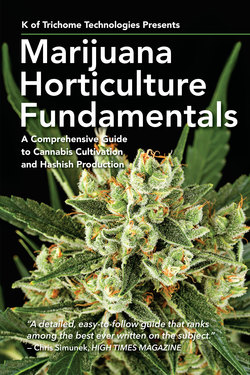Читать книгу Marijuana Horticulture Fundamentals - K of Trichome Technologies - Страница 5
На сайте Литреса книга снята с продажи.
ОглавлениеContents
Foreword by Zorro
Foreword by Mel Frank
Introduction
About the Author
Acknowledgements
Quotes
Marijuana Terminology by Mel Frank
The Definition of “Strain”
Chapter 1
Cannabis Basics and Gender
Males
Females
Hermaphrodites
Sinsemilla
A Note on Calyx-to-Leaf Ratio
Chapter 2
Grow Security
Legalities
Visibility
Electricity
Odors
Moisture
General Advice
Chapter 3
The Symbiotic Rotation Process
Choosing a Cultivar
Cannabis Sativa
Cannabis Indica
Symbiotic Rotation Timeline
The Eleven Steps of Symbiotic Rotation
Altering Cycles
Chapter 4
System Basics
Growroom Basics
Existing Structures
Building a New Environment
Precautions
Greenhouse
Tips for Greenhouse Growing
Indoor Soilless Shelf System
Organic Soil Shelf System
Simple, Hand-Fed, Soilless Water System
Hand-water Rockwool System
Hand-water Rockwool Cube System—Run to Waste
Soilless Drip System—Run to Waste
Basic Drip System
Deep Water Culture (NFT)
Run-to-Waste System
Drip System (with Hydroton)
Ebb and flow
Recirculating NFT Bucket System
Aeroponics
Closet Cloning
Growtubes
Timers, Ballasts, Wiring
Drying Racks
Chapter 5
Growing Medium
Soil vs. Hydro
Medium / Drainage / Aeration / Container Size and Shape
Rockwool Tips
Advice for the Beginner
Growing in a Soilless Mix
Nutrient Mix and Salt Buildup
Chapter 6
Ventilation, Heat, and CO2
Ventilation
Heat
Heaters
Thermostats and Humidistats
CO2
Chapter 7
Lighting
Air-Cooled Lights
Light Coverage and Layout
Light Distance from Plants
Light–Ballast Distances
Basic Bullets
UVB Light
Chapter 8
Choosing a Cultivar
Cannabis Sativa
Cannabis Indica
Cannabis Indica / Sativa Hybrids
Getting seeds
Storing Seeds
Clones
Chapter 9
Seed Germination
Propagating Clones / Germinating Seeds Intended for Outdoor Growth
Determining Plant Sex
Cloning for Sex
Environmental Influences on Plant Sex
Chapter 10
Vegetative Growth
Beginnings
Preparation for flowering
SCROG (Sea of Green) / Training Your Plants
Chapter 11
Water and Feeding
Water Quality and Preparation
Feeding
Ideal Nutrient Levels for Cannabis
Tea
Foliar Feeding
Temperature Control, Sterilization, and Oxygenation of Reservoirs
Temperature and Watering
To Recirculate or Not to Recirculate
Humidity
Dew Point Explained
Basic Facts
Extra Background
Manipulating the Light Cycle to Conserve Electricity
PPM (Parts Per Million)
Transpiration
Inspecting Runoff Water
Stomata
Water Preparation, Step-by-Step
pH
Blending the Ultimate Organic Soil Mix
Nutrient Timing and Burn Periods
Seaweed / Kelp Meal
Potassium Sources
Phosphorous Sources
Sulfur Sources
Dolomite Lime
Reusing / Recycling Your Soil
Method
Earthworms
Earthworm castings
What Not to Do
Unsulfured Blackstrap Molasses
Curing Soil
Recycled Soil Structure and Composition
Using Your Harvest Leftovers
Beneficial Nematodes
Preferred Soil Amendments and Plant Spray Checklist
Organic Fertilizers
Recommended Organic and Non-Organic Soil Amendments
Preventing Soil Drainage Problems
Evaluate Your Soil
Minimizing Water Loss / Evaporation
Examine Your Outdoor Soil
Organic Tea
How to Brew Organic Compost Tea
Basic Foundation Tea Recipe (for Vegetative and Flowering Growth)
Introduction to General Hydroponics’ Flora Series Liquid Concentrated Nutrient
Products and Nutrients
Water-Retaining Crystals
Watering Interval
Outdoor Soil Augmentation
Soil-Mix Augmentation
Clay-Dominant Soil Augmentation
Correction for Elevated pH Levels in Soil
Correction for Lower pH Levels in Soil
Replacing Soil
Introduction to Fertilizers and Organic Amendments
Organic Fertilizers
Inorganic and Synthetic Fertilizers
Soil Amendments
Powdered Fertilizers
Liquid Fertilizers
Application Timing
Animal Waste
Pythium and Pathogens
Nutrient Enhancers
Chlorine, Contaminants, Aeration, and Their Importance
Water
Water Hardness
When is Water Too Dirty?
Well Water and City Water: Sources and Composition
Reverse Osmosis
Reverse Osmosis vs. Charcoal
Chapter 12
Cloning
What is a Clone?
Materials Called for in this Chapter
Clone How-To
Clone Considerations
Sources
Traditional Cutting Methods
Mother / Donor Plants
Gardex Substrate
Avoid Stagnant Water
Aeroponic Cloning Machines
Rooting Hormones
Types of Containers
Water, pH, Nutrients
Plant Preparation
Taking Cuttings
Transporting Cuttings
Cloning Tips
Start Clean
Reduce Stress
The Right Cuttings
Proper Media
Proper Temperature
Rooting Hormones
Sticking
Proper Density
Fertilization and pH
The Rooting Process—Toning
Determining Sex
Root Development
Chapter 13
Flowering
Males/Hermaphrodites/Sinsemilla
The Flowering Stage
Nutrient Management
Cleanup and Secondary Stripping
Accelerating Maturation
The Flowering Cycle Timeline
Outdoor and Greenhouse Flowering Methods
Flowering Tips
Excess Temperature
Light Distance, from Bulb to Plant
Sulfur
Prewatering
Foliar sprays
Flushing and Organics
Mineral Salt-Based Synthetic Fertilizers
Chapter 14
Harvest
Harvesting
Trichomes
Timing
Harvest Timing
Prepare for Harvest
Clothesline Method
Manicuring
Bagging and Moisture
Curing
Harvest Tips – Cleaning Up
Dry Air = Increased Resin
Harvest Tips
Chapter 15
Curing
Curing Tip
Chapter 16
Problems: Mold, Pests, Diseases, and Nutrient Deficiencies
Typical Problems
Seeds and Seedlings
Established / Young Plants
Flowering Plants
Fungi
White, Powdery Mildew
Management and Control
Cultural Control
Environmental Control
Powdery Mildew and Hash
Pest Prevention
Air Filtration
Pyrethrum (Aerosol Bug Bombs)
Aphid and Whitefly (Yellow) Sticky Traps
Thrip (Blue) Sticky Traps
BT: Bacillus Thuringiensis
Neem Oil
Botrytis
Prevention and Control Tips
Pests
Snails and Slugs
Animal Repellant
Rattlesnakes or Other Poisonous Snakes
Caterpillars
Spider Mites
Thrips
Aphids
Nutrient Deficiencies
Introduction
Salt Buildup
Nutrient Deficiencies and Excesses
Nitrogen
Phosphorous
Potassium
Calcium
Magnesium
Sulfur
Iron
Manganese
Zinc
Copper
Boron
Molybdenum
Chlorine (Chloride)
Fluoride
Nickel
Cobalt
Sodium
Silicon
Acceptable Limits and Average PPM Information
A Final Note on Nutrient Excesses and Deficiencies
Chapter 17
Hash Making
Scissor and Finger Hash
Sieving
Cold Water Hashish Extraction
Basic Water Extraction Method
Resinizer (from Aqualab Technologies)
Clear Jar Resin Cleaning Method
Hash Oil
Optional Extras
Starting Materials
Preparation
Using a Heat Source
Using Condensers
Pressing Hashish
Pressing—Pros and Cons
A Note on Powdering and Pressing
Advanced Methods
Hash Making Tips
Useful Products
Appendix
Appendix 1: Screen Sizes
Screen Size Measurement
Appendix 2: Terpene Extraction: The Future of Dabs
Appendix 3: Commonly Asked Questions
Appendix 4: Six Simple Preventative Tips
Dedication
Index
